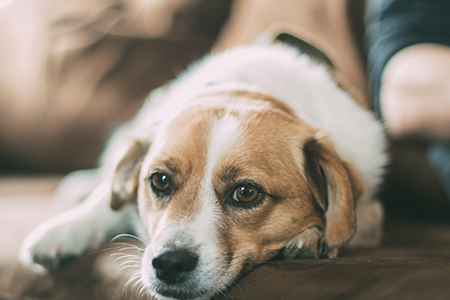 Moving can present an exciting opportunity, but if you’re a pet owner and a renter, the normal chaos of packing up could be accompanied with stress over how to handle the damage your pet has done to the property over time. As you notice each thing your furry family member has been responsible for, you might get a sinking feeling there’s no way you’ll get your security deposit back or worse, your home might have lost a significant amount of value.
Moving can present an exciting opportunity, but if you’re a pet owner and a renter, the normal chaos of packing up could be accompanied with stress over how to handle the damage your pet has done to the property over time. As you notice each thing your furry family member has been responsible for, you might get a sinking feeling there’s no way you’ll get your security deposit back or worse, your home might have lost a significant amount of value.
Fortunately, there are several things you can do to fix the unsightly pet-related problems around the house.
Clean Carpeting with Baking Soda and Vinegar
Even if you have a thoroughly house-trained dog or a cat that understands how to use the litter box, you’ve probably had to deal with pet urine stains on your carpet. However, they’re more stressful if they happen when trying to get the house spruced up for a move-out inspection. Act quickly and use a natural solution. That way, you won’t have to worry about your pet coming in contact with chemicals during your remaining time in the house.
If you’re dealing with a very recent stain that’s still moist, carefully blot it with a paper towel.
Then apply a mixture of equal parts water and vinegar and soak it. If the stain is especially bad, use pure vinegar instead. Once you’ve soaked the area, scrub as hard as possible to get down into the deepest carpet fibers. After that, add a bit of baking soda and leave the spot until it’s dry. Finally, vacuum the area.
It’s crucial not to wait too long before cleaning pet stains. If the urine reaches the padding underneath the carpet, the method above may not be powerful enough. You might have to rely on a carpet cleaning company that uses water extraction methods to get the job done.
Remove Pet Odors from Hardwood Floors
Perhaps the home you’re moving out of doesn’t have visible pet stains, but you’ve noticed areas covered with hardwood material seem to have absorbed the odor of your pets. Because certain cleaning agents can be very harsh on hardwood floors, it’s important to find some that are gentle, yet effective.
Vinegar starts removing bad smells almost immediately. Alternatively, baking soda and hydrogen peroxide can also do the trick. All three could weaken the sealant or cause bleaching if not applied carefully or if left on too long, so don’t leave the area unattended.
Improve Wood Furniture That’s Been Chewed by a Dog
It’s certainly stressful to come home from a day at work to discover your dog has decided wooden furniture is a more adequate chew toy than the items you’ve provided for playtime. If it seems your dog is repeatedly chewing wood furniture and eating the shavings, it may be a self-inflicted injury worth consulting your veterinarian about.
Once you’re satisfied the dog isn’t intentionally chowing down on the furniture due to a behavioral or physical problem that needs attention, turn your efforts toward improving the damaged wood. Take a utility knife and cut small, diagonal hatch marks across the chewed area. Hold the blade directly in your hand if possible to maintain good control, and put masking tape over the sharp parts to protect your skin. Then, make a batch of auto-body filler according to the packaging instructions. You’ll probably have to put several applications on the affected area to build up the surface so it’s flush with the part that hasn’t been chewed.
However, once applied, the substance dries in about five minutes, so be careful not to prepare too much at once.
Put the auto-body filler on a paper plate and mix it well for 30 seconds. Then, cover the chewed wood with the filler and wait until it’s dry, but not hardened. If necessary, use a knife blade to carve away excess filler, and sandpaper to smooth out the surface. You can also run a wax fill stick over the sanded surface to fill in any remaining small holes. This wood repair method may seem a little involved, but it’s something you can try even without having carpentry knowledge.
Conceal Claw Marks on Leather Furniture
Cats are arguably more likely than dogs to scratch leather furniture with their claws, especially since they naturally need to sharpen them on surfaces regularly. Ideally they’d use scratching posts, but that doesn’t always happen. Furthermore, dogs may unintentionally leave claw marks on leather, especially if they feel they are slipping and try to grip the surface. Luckily, there are ways to make claw markings less visible.
If the area is only slightly affected so the leather appears to have an abrasion, try applying white vinegar with a soft cloth. The vinegar makes the leather swell, which may hide the marks. Using leather polish after the vinegar should conceal mild scratch marks even more.
If the marks are so severe they have created tears, you’ll need to use a leather repair kit that includes a solution tinted about the same color as the damaged material. Insert a scrap of fabric, such as an iron-on patch, into the hole to add stability. Put grain paper with the grain side down over the material after you’ve applied the repair solution. Iron the grain paper as a finishing touch, then pull it away to see the results.
Moving can be stressful, but thanks to these tips, you can stress less when getting the property ready to vacate.
Megan Wild is a dog owner who loves spending time at home with her pup, Tucker. When she’s not on a hike outside, she loves designing and improving her home. You can find her tips and ideas on her personal blog, Your Wild Home.
This post was originally published on RISMedia’s blog, Housecall. Check the blog daily for top real estate tips and trends.










